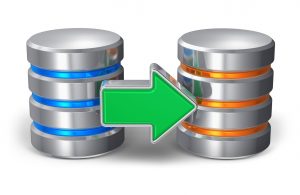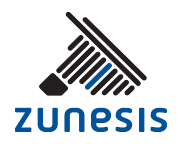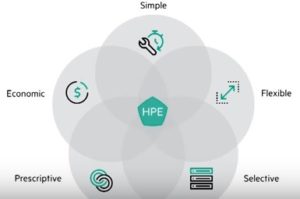Have you heard about Zerto? More importantly, are you using Zerto?
Zerto is taking the IT world by storm, providing a simple, yet fully functional, replication and data protection Disaster Recovery (DR) solution.
What makes Zerto so unique is its simplicity.
Zerto Virtual Replication 4.5 was recently released, and this blog provides a description of some of the additional functionality provided in 4.5. (If you would like to learn more about Zerto aside from the newest features released in 4.5, please reach out to Zunesis.)
Zerto Virtual Replication 4.5 builds upon their always-on replication, with no snapshots, replication and orchestration capabilities by adding granular recovery. Now, a single file or folder can be recovered from the journal, improving the average time to recovery for files, folders, VMs, applications, and sites.

Many other improvements were made to simplify disaster recovery operations, further reducing ongoing management and maintenance, and to automate more DR operations to ensure consistency and repeatability.
File and Folder Recovery from the Journal – What is the most common disaster that administrators must recover? It isn’t natural disasters or site outages; it is actually lost or accidently deleted files or folders. In release 4.5, Zerto solves this most frequent disaster problem by adding the ability to recover a single file or folder from up to 14 days in the past, from increments in seconds from the journal with just a few mouse clicks. With other solutions, the file is pulled from nightly infrequent backups, which could result in data loss and missed user expectations.
Improved Role-Based Access Control – The security of your business continuity and disaster recovery plan is of the utmost importance. It is imperative that those who are making changes or updates fully understand the impact of these changes in the event that recovery is needed. In addition to the already robust permissions available from Zerto Virtual Replication, these have been added.
View Only – The ability to log into Zerto Virtual Replication and view the settings and configurations of the BC/DR processes. This permission level does not allow for changes to be made.
Manage Workload Protection – The ability to modify virtual protection group (VPG) settings and update BC/DR plans and processes.
Recover and Migrate Workloads – The ability to actually execute the BC/DR or migration plan. Workloads will move according to the execution plan.

With 4.5, Zerto introduced new APIs to further automate VPG creation, protecting VMs and simplifying BC/DR operations:
- Simplify management with the ability to upgrade, install, uninstall, and configure Zerto Virtual Replication Appliances
- Effectively monitor alerts with all the active alerts provided with the ability to dismiss/retain alerts
- Fully automate the creation and editing of VPGs including VMs, networks, volumes, and NIC configuration to reduce install and ongoing maintenance
- Respond to changing business requirements with the ability to add and remove VMs from or to a VPG
- Increase storage efficiency with compression on the journal
- Extend the history of an application with less storage used.
In summary, Zerto Virtual Replication 4.5 ensures the continuous protection of applications, VMs, folders, and files. This increased granularity gives organizations unprecedented control over recovery operations. New APIs and role-based controls ensure the right commands are accessed and executed, further increasing control of critical IT operations.
To learn more about Zerto or to see a technical demonstration, please contact Zunesis at info@zunesis.com.
I’m sure there will be no surprised reaction when I state that we live in a data driven world. For proof you have to look no further than the people around you as you go throughout your day. Unless you’re hiking through the desert, you’re going to see many people with their heads down, looking at their smartphones as the read and send emails, texts, and tweets. From this same smartphone they will search for information, store notes, review documents, and the list goes on and on (what can’t a smartphone do these day?!)
Here’s the thing about this: All of the information they are creating and accessing is stored somewhere. It is this unabated demand for immediate and reliable data access that has created an unprecedented evolution in Storage technology. And it is the technology industry’s response (an explosion of Storage options) that makes the task of choosing your next Storage Array so difficult.

As businesses look to refresh their storage technology today, they are met with a dizzying menu of features including thin provisioning, deduplication, compression, iSCSI, File, Fibre Channel, All Flash, Hybrid, Tiering, etc.
Of course, the question is which of these features will be relevant for any given environment. The final answers will, of course, vary by environment. However, even after you’ve assessed your needs and ranked your requirements, you will still be faced with an increasingly crowded field of solution options from both established manufacturers and those who are new to the industry.
In my view, if you aren’t including HPE 3PAR StoreServ in your short-list, you may want to reconsider. Not only is HPE an established manufacturer, the 3PAR StoreServ is a mature array family and will match all the features/functionality of its competitors.
What’s more, the family of arrays included in the StoreServ solutions include options that will fit price/performance for Entry level, Midrange, and Enterprise arrays – all of these with the same features and functionalities. Furthermore, you’ll find both All Flash and Hybrid models to suit your requirements.
Here are just a few of the features and functionality you’ll find in the HPE 3PAR StoreServ family:
- Thin Provisioning – Up to 50% reduction in your storage footprint if you are fully provisioned today.
- Dynamic Optimization – The ability to migrate entire volumes to different tiers or RAID levels non-disruptively.
- Adaptive Optimization – The ability to migrate volumes at the sub-volume level based on policies you choose. This too is done non-disruptively.
- Deduplication – The ability to eliminate duplicate blocks and reduce storage footprint, in addition to what Thin Provisioning provides.
- Federation – The ability to migrate volumes/workloads across arrays non-disruptively.
- Priority Optimization – The ability to prioritize IOPS, Throughput, and Latency on a per volume basis.
- Data Encryption – Encryption of data-at-rest.
- File Persona – Serve data via CIFS and NFS directly from the array.
- Fibre Channel and iSCSI
- Detailed Reporting
- Application Integration – For Vmware, Hyper-V, SQL, Exchange, and Oracle.
 And, if you want some validation of how well the 3PAR Family stacks up against its competition, you may want to look at the publications from DCIG, Storage Magazine, Gartner, and TechTarget. Links to these publications and more detailed information about the HPE 3PAR StoreServ can be found at www.hpe.com/us/en/storage/3par.html.
And, if you want some validation of how well the 3PAR Family stacks up against its competition, you may want to look at the publications from DCIG, Storage Magazine, Gartner, and TechTarget. Links to these publications and more detailed information about the HPE 3PAR StoreServ can be found at www.hpe.com/us/en/storage/3par.html.
And, of course, Zunesis is ready to help you understand the benefits of 3PAR for your environment. In fact, if you’d like to spend some time on a 3PAR array, we have three HPE 3PAR StoreServ arrays in our Lab and would love to host you for a POC in our Englewood, CO facility. Please contact us if you are interested in taking a closer look at this technology.
Using Data to Determine the Best Way to Store Your Data
Numbers can be made to say many things. To quote one of the most innovative thinkers of our time: “Aw, you can come up with statistics to prove anything. Forty percent of all people know that.” – Homer Simpson
True, numbers can be spun in numerous ways, but data can’t be denied. Along those lines, decisions in IT revolve around very expensive purchases – and buyers need facts to support every purchase.
So, here are some facts:
 In storage, what we see is a market slowly slipping, with all the stalwarts declining faster than the overall market (2.3% in 2015)… all except one: Hewlett Packard Enterprise. 2015 Revenue was down for EMC by 5.9% and NetApp 14.3% (ouch!). Dell Revenue was down 5.6% last fiscal year as well. IBM is now an anecdote.
In storage, what we see is a market slowly slipping, with all the stalwarts declining faster than the overall market (2.3% in 2015)… all except one: Hewlett Packard Enterprise. 2015 Revenue was down for EMC by 5.9% and NetApp 14.3% (ouch!). Dell Revenue was down 5.6% last fiscal year as well. IBM is now an anecdote.
Smaller players are not to be overlooked. Pure is on fire with Q4 showing a 152% gain in revenue, but those numbers come at an awful price. 2015 saw a $213.7 million loss actually up from $183.2 million loss in 2014.
HPE has a really good story right now. Split into two companies, the infrastructure enterprise is slimmer, more nimble (pun intended) and it’s the only major storage player growing. HPE is up 7.9% in Q4. That alone is pretty good; but in a segment down 2.2% in the same period, that’s even more impressive.
DCIG rated 3Par as the best Enterprise midrange array. On March 8, 2016, the Storage Performance Council (SPC) released a new SPC-1 result for the 3PAR StoreServ 8450 All-Flash Array, where it achieved a world-leading result of $0.23 SPC-1 $/IOPS™ – making it THE most affordable external all flash array on the planet.
3Par is the only array in Gartner’s magic quadrant for solid state and general purpose – and those are both managed from the same interface.
To put this all into context, if you’re a decision maker looking to make a large investment that’s going to last for the next several years, doesn’t it seem wise to at least look at the only major storage provider that’s healthy, growing, and that also happens to be racking up major accolades?
The business of IT, that is.
Data Protection, Fault-tolerance, Disaster Recovery, and Business Continuity are issues all IT Professionals deal with on some level throughout their career. As important as all four of these are to a business, until recently, only the first two have really been given any attention.
In fact, Data Protection and Fault-tolerance are considered to be fundamental components of any professionally run IT environment. The basic level of Data Protection is, of course, defined by file backup and recovery solutions. When we talk with our clients about Data Protection, these discussions typically start with questions about the software used and the type of media employed to store the backups. For Fault-tolerance, the conversation revolves around discussions of redundancy in your hardware, clustering, and RAID levels.
 In contrast to Data Protection and Fault-tolerance, Disaster Recovery and Business Continuity have, for years, been part of the annual budgeting discussion but usually end up in the “nice to have” pile and are set aside until the next budget cycle. The cost and complexity of these solutions ended up being too expensive and require too many resources to implement. However, within the past 3 to 5 years, we have seen many of our clients elevate the Disaster Recovery and Business Continuity conversations from the “nice to have” to a “must implement” discussion.
In contrast to Data Protection and Fault-tolerance, Disaster Recovery and Business Continuity have, for years, been part of the annual budgeting discussion but usually end up in the “nice to have” pile and are set aside until the next budget cycle. The cost and complexity of these solutions ended up being too expensive and require too many resources to implement. However, within the past 3 to 5 years, we have seen many of our clients elevate the Disaster Recovery and Business Continuity conversations from the “nice to have” to a “must implement” discussion.
There are many factors contributing to the change, but I would contend the two biggest reasons are:
- The extreme dependence most businesses have on the digital world. Reverting to legal pads and cigar boxes simply aren’t options for many businesses today.
- The technology has made implementation of Disaster Recovery and Business Continuity easier and more affordable to accomplish than ever before.
With the ubiquity of virtualization today, discussions about all of these issues has changed significantly. Where once we drew well defined lines between the solutions for Data Protection, Fault-tolerance, Disaster Recovery, and Business Continuity, we are now starting to see those lines blur. To be clear, each of these issues still addresses distinctly different solution requirements. However, technology is allowing us to combine some of these requirements under one toolset.
Even though one solution may cover multiple requirements defined by Data Protection, Fault-tolerance, Disaster Recovery, and Business Continuity, it’s important to go into discussions of these issues understanding the major differences between them.
- Data Protection – These solutions are focused on protecting files and databases from corruption or deletion. In either event, Data Protection solutions should be able to restore a file or database from a point in time. While the file or database may not contain the most recent updates, it is still better than not having it at all.
- Fault-tolerance – As the name implies, these solutions allow part of the hardware or software to fail without losing the entire device or application. For hardware this is accomplished through redundant power supplies and fans. It also includes the implementation of RAID on the disks or clustering for operating systems or hypervisors. Fault-tolerance is usually a protection against a local failure.
- Disaster Recovery – Again, as the name implies, these solutions provide the ability to recover from a disaster. In general, these solutions replicate data and applications to another location or Disaster Recovery Site. The Disaster Recovery Site will typically have compute, network and storage resources to be able to bring part or all of a production environment online in a predetermined period of time; usually defined by hours. The key here is what that period of time will be and to what point in time the data will be recovered. These are more commonly referred to as the RTO and RPO.
- Business Continuity – While Disaster Recovery is designed to bring a business back on line in hours or a few days, Business Continuity is designed to keep a business running in the event of a disaster or, at the very least, have the business running again in minutes and with the most up-to-date data sets.
 As I mentioned earlier in this post, technology today has made implementation of solutions to these four issues far easier than it used to be. However, defining the requirements and navigating through the many solution options can still be a daunting task. At Zunesis we have Solution Architects, with decades of experience, who are ready to help our clients design solutions to protect their Business. With all the options available today it is important to have a partner with the expertise to design, acquire, and implement these essential solutions.
As I mentioned earlier in this post, technology today has made implementation of solutions to these four issues far easier than it used to be. However, defining the requirements and navigating through the many solution options can still be a daunting task. At Zunesis we have Solution Architects, with decades of experience, who are ready to help our clients design solutions to protect their Business. With all the options available today it is important to have a partner with the expertise to design, acquire, and implement these essential solutions.
In addition to experienced Solution Architects, Zunesis partners with some of the most respected names in the industry to provide the hardware and software needed to implement a Business Protection plan. Our partners include Hewlett Packard Enterprise, VMware, VEEAM, Commvault, Zerto, Dakota Cloud Recovery, and others. Click here for a full list of partners.
In future blog posts we may delve into some of the discovery process and solutions more deeply. Until then, you can be sure that, with our experience and our strong partnerships, Zunesis can help achieve your objective of protecting the business today.
Zunesis is recognized in the CRN’s industry standard for the most successful solution provider companies, the Solution Provider 500.
Denver, CO (PRWEB) June 06, 2016
 Zunesis, a Denver-based IT solution provider, announced today that CRN®, a brand of The Channel Company, has named Zunesis to its 2016 Solution Provider 500 list for the sixth time. The SP500 list is CRN’s annual ranking of the largest technology integrators, solution providers, and IT consultants in North America by revenue.
Zunesis, a Denver-based IT solution provider, announced today that CRN®, a brand of The Channel Company, has named Zunesis to its 2016 Solution Provider 500 list for the sixth time. The SP500 list is CRN’s annual ranking of the largest technology integrators, solution providers, and IT consultants in North America by revenue.
The SP500 is CRN’s predominant channel partner award list, serving as the industry standard for recognition of the most successful solution provider companies in the channel since 1995.
Zunesis’ ability to earn this recognition time and time again is a testament to their consistent dedication to their clients. Despite unprecedented change in the IT industry over the last decade, Zunesis has found a way to adapt to the changing marketplace and meet the needs of their clients through each phase of technology’s evolution.
“We’re honored to make this list again,” said Zunesis CEO, Steve Shaffer. “I could not be more proud of the team at Zunesis who is committed to the best interests of our clients. In this constantly-changing IT landscape, our employees always rise to the challenge. No matter what new technologies we need to learn or creative solutions we need to build, my team is always up to the task of providing the absolute best solution to the customer.”
“The 2016 Solution Provider 500 represent a total, combined revenue of over $334 billion—a testament to their success in keeping pace with the rapidly changing demands of today’s IT market,” said Robert Faletra, CEO, The Channel Company. “This prestigious list recognizes those companies with the highest revenue and serves as a valuable industry resource for vendors seeking out top solution providers to partner with. We congratulate each of the Solution Provider 500 companies and look forward to their continued success.”
A sampling from the 2016 Solution Provider 500 list will be featured in the June issue of CRN Magazine and at http://www.CRN.com/sp500.
About Zunesis
Zunesis is a leading IT solution provider with locations in Colorado and Nevada. Our vision centers around an intense focus on serving our customers and bringing value to their business through strategic IT solutions. In 2015, Zunesis was added to the CRN Next-Gen 250 list, recognizing them for their innovation and forward-thinking in the industry. Later, in March 2016, Zunesis was named to the CRN TechElite 250 for the 7th consecutive year as a best-of-breed solution provider with deep technical expertise and premier certifications. For more information, visit the Zunesis Blog or follow us on LinkedIn.
About the Channel Company
The Channel Company enables breakthrough IT channel performance with our dominant media, engaging events, expert consulting and education, and innovative marketing services and platforms. As the channel catalyst, we connect and empower technology suppliers, solution providers and end users. Backed by more than 30 years of unequaled channel experience, we draw from our deep knowledge to envision innovative new solutions for ever-evolving challenges in the technology marketplace. http://www.thechannelco.com
Composable Infrastructure: The Engine for the Idea Economy
In an effort to move toward an Idea Economy, IT must now be able to support two operating environments.
- Traditional Business based off of traditional apps which are Ops driven and cost focused
- Idea Economy which encompasses cloud apps which are Apps driven and agility focused
A new category of infrastructure is needed to power the Idea Economy. In the traditional model, Application and Operations optimization took months to deliver. Converged Infrastructure took days, Hyper-converged took minutes, and now Composable takes seconds.
 Composable Infrastructure, also known as HPE’s new Synergy, simplifies Infrastructure as a Service by providing the following:
Composable Infrastructure, also known as HPE’s new Synergy, simplifies Infrastructure as a Service by providing the following:
- Hardware and software architecture as one
- Fluid IT
- Software-defined everything
- Unlimited scale
- Physical, virtual, and containerized workloads
Composable Infrastructure is the new engine for the Idea Economy allowing customers to take leaps and bounds:
- REDUCE over-provisioning and CAPEX. Users can precisely compose any compute with any storage pool.
- DEPLOY at cloud-like speed. Power up to a portal in minutes.
- DEVELOP more apps, faster. Program Infrastructure the way you want.
- UPDATE firmware seamlessly. Frictionless operations reduce operational effort.
HPE’s Composable Infrastructure multi-year vision empowers IT to create and deliver new value instantly and continuously for traditional business and the Idea Economy.
- Run Anything – Optimize all apps and service-levels.
- Move Faster – Accelerate app and service delivery.
- Work Efficiently – Reduce operational effort and cost.
- Unlock Value – Increase productivity and control.
The path to Composable Infrastructure allows an ease of management and interoperability across the entire infrastructure. Converged Blocks with Composable attributes provide value to your existing infrastructure. With HPE’s fully Composable Infrastructure, you receive continuity and investment protection of tools, integration, and process. HPE’s Composable Infrastructure transforms cost to value creation with infrastructure that bridges traditional and new.
Choose Less Expensive, More Available Laptops and Desktops.
Before we get into talking about why you should shop HP Inc. (HPI) for all your desktop and laptop needs, I have a fun fact for you. I have always been a devotee of strange or obscure “did you know” type facts or trivia.
These days, we are inundated with fun facts on our social media pages, so it is harder to find obscure pieces to share. However, I think I have one for you today. If someone were to ask you, “Who is a bigger movie star, Adam Sandler or Brad Pitt?” what would you say? If you are like me, I would say Brad Pitt without hesitation. I mean, his movies are always well publicized and celebrated. He has a very famous wife and friends who attend his movie premiers. Seems like there just is no doubt, right? Well, as Lee Corso would say, “Not so fast, my friend.”
 Did you know that according to the website Box Office Mojo, Adam Sandler has had more movies that have grossed over 100 million dollars than Brad Pitt (15 to 11)? Or that Adam Sandler has a higher average gross per movie than Brad Pitt ($83,155,354 vs $67,023,468)? I can imagine you are thinking, “This can’t be! Brad Pitt is a mega A list star, and Adam Sandler is…well…Adam Sandler. Sure, his movies are entertaining (sometimes), but he is not like Brad Pitt!” This surprise factor is what makes this bit of information so entertaining to me. Perception and hype do not always meet up with real world results.
Did you know that according to the website Box Office Mojo, Adam Sandler has had more movies that have grossed over 100 million dollars than Brad Pitt (15 to 11)? Or that Adam Sandler has a higher average gross per movie than Brad Pitt ($83,155,354 vs $67,023,468)? I can imagine you are thinking, “This can’t be! Brad Pitt is a mega A list star, and Adam Sandler is…well…Adam Sandler. Sure, his movies are entertaining (sometimes), but he is not like Brad Pitt!” This surprise factor is what makes this bit of information so entertaining to me. Perception and hype do not always meet up with real world results.
I find that this same lesson can be applied to our everyday jobs. For me, it is especially true in the world of Desktops and Laptops. It seems that the perception for our industry is that Dell is the manufacturer that is less expensive and has more available product. With other companies, like HPI, you have to pay a premium for a “higher end” product. Or in some cases, you’re just paying for the darn HP name to be branded on the product.
However, like the example above, the real world result is very different. HPI provides hundreds of pre-configured and in stock promotional “Smart Buy” options that can be delivered fast (in most cases overnight) and are at a very aggressive price point to their competition. What is even better is that even if these pre-configured models do not meet your specification exactly, HPI provides their partner community the upgrades to make changes to these Smart Buys quickly and easily.
Again, I can imagine what you might be saying: “Hundreds of options, I do not have the time to sort through all of that!” That is where your friendly neighborhood partner (Zunesis 🙂 ) can come in handy. We are just a phone call or email away, and we have the knowledge and information to find you the right product and get it shipped to you quickly!
10 years ago we got our breaking news from radio and TV. Remember being glued to the television when a big news story broke?
Today, the tables have completely turned. We all know how social media has changed the marketing forefront, but it doesn’t get enough credit about how it changed the entire public relations industry.
Five years ago, news and media outlets didn’t want to start pushing their content on social media. They were forced to. Independent journalists starting using various digital tools like Twitter, Evernote, and Facebook to start reporting on topics “live” during an actual event. Quickly, bigger media/news entities starting seeing the traction these independent journalists were getting. These journalists, who were using social media as a PR tool, were actually hurting ratings of corporate media outlets.
This was when the whole PR industry changed.
Now integrating social media in your public relations strategy is PR industry standard. The PR world embraced social media with open arms, and has used various digital tactics to advance how everyone uses social media in their public relations strategy. Listed below are three tactics on how you can use social media as a critical PR tool.
1. Social Media Listening
 One of the reasons why everyone loves Twitter is because of the live trends you can see all over the world. Twitter gave us the ability to listen and see the most talked about topics online.
One of the reasons why everyone loves Twitter is because of the live trends you can see all over the world. Twitter gave us the ability to listen and see the most talked about topics online.
Having the ability to listen to industry specific conversations online is powerful. Having strong data like this in your back pocket to help you understand multiple online audiences that are custom to your industry can be HUGE to your PR strategy.
2. Turn Press Releases into Blogs
Press releases are a great way to get information about your company into the right hands when it comes to media outreach. One thing we’ve seen companies fail to do, however, is turn their press releases into a nice blog post. Yes – You will have to make some minor layout/format changes, but if you have a BIG announcement, then you should be sharing that content across multiple channels.
In today’s world, content is king. Most well-written press releases are great pieces of company content. And the truth is, most press releases never get picked up by the media. So why not, since you invested the time in creating valuable content for a press release, turn it into a blog post? This allows you to have a new and different set of eyes on your release.
Not only should you turn your release into a blog post, you need to make it shareable. We believe this is a best practice with all your blogs, but especially a press release that includes a product launch or big-time company event and announcement. No longer should companies be sending their press releases “down the wire” in hopes it gets picked up. They should be sharing it across multiple channels, allowing their key audience to not only see the release, but share it too.
3. Customer Service – Reputation Management
 Not only has public relations changed because of social media, but so has the world of customer service. Social media now gives our customers a platform to engage with us in both a positive and a negative light.
Not only has public relations changed because of social media, but so has the world of customer service. Social media now gives our customers a platform to engage with us in both a positive and a negative light.
Social media gives our customers the option for reviews, feedback, and questions. This is why many businesses now have full time staff or an agency helping to manage their social media.
How your company is seen on social media is a big for your overall reputation management within your industry. If your company has a lot of negative reviews on Facebook, obviously you can see how this could hurt your brand and reputation.
On the flipside though, if you have a lot of positive engagement and reviews, this can increase your reputation. Having a strong customer service presence is key in today’s social media, which helps your overall reputation.
We now live in a day where we have to be responsive to our clients and customers online. If we aren’t, this could really hurt our overall brand from a public relations standpoint.
As 2016 begins there are two very large IT contributors going in opposite directions. On one side of the coin, we have Dell looking to acquire EMC for $67B, which is beyond comprehension. On the other side we have HP splitting itself in 2 and trimming itself down to better address the changing Enterprise market challenges. Which will rise to the surface may take a few years to know for sure (assuming we ever find out).
DELLware
Looking at – not sure what they will call themselves – DELLware (my choice) we see two giants trying to fill the whitespace neither has covered. Adding in the VMware factor on the EMC side and the majority Nutanix ownership with DELL gives rise to potential interesting future offering. That is if NSX has the legs necessary to carry the somewhat marginal offering in the Network space today. The acquisition price will surely require a large selloff of valued assets; and with all this, will there be any $’s left in R&D to make this new offering viable? Time will tell as it tells all.
Hewlett Packard Enterprise
 While DELL/EMC are beginning their journey, HP has completed theirs and will be looking to hone its Enterprise offering in a more targeted way. HP has lost its voice over the past few years, and many of its longtime customers have “broken up” with HP technology. Cisco has made a huge dent into the Blade market, hurting what once was the cornerstone or HP’s future. Improvements in server density offerings like Moonshot should be well positioned for future high performance application scaling. HPE’s acquisition of Aruba has certainly improved HPE’s Network offering. With Openflow already being available on certain HPE switches, they are positioned nicely to chip away at Cisco in the Virtual Switch space.
While DELL/EMC are beginning their journey, HP has completed theirs and will be looking to hone its Enterprise offering in a more targeted way. HP has lost its voice over the past few years, and many of its longtime customers have “broken up” with HP technology. Cisco has made a huge dent into the Blade market, hurting what once was the cornerstone or HP’s future. Improvements in server density offerings like Moonshot should be well positioned for future high performance application scaling. HPE’s acquisition of Aruba has certainly improved HPE’s Network offering. With Openflow already being available on certain HPE switches, they are positioned nicely to chip away at Cisco in the Virtual Switch space.
HPE – being smaller and having taken the Capital hit needed to split off – sits in a very strong position for acquisitions to grow their portfolio…DELLware not so much. Stay tuned, this is going to be an interesting next few quarters as all of this comes into focus.
Tech Elite 250 list recognizes IT solution providers with deep technical expertise and premier certifications. Zunesis made the list for the 7th year in a row.
Denver, CO (PRWEB) March 28, 2016
 Zunesis announced today that CRN®, a brand of The Channel Company, has named Zunesis to its 2016 Tech Elite 250 list for the seventh consecutive year. This annual list honors an exclusive group of North American IT solution providers that have earned the highest number of advanced technical certifications from leading technology vendors.
Zunesis announced today that CRN®, a brand of The Channel Company, has named Zunesis to its 2016 Tech Elite 250 list for the seventh consecutive year. This annual list honors an exclusive group of North American IT solution providers that have earned the highest number of advanced technical certifications from leading technology vendors.
To compile the annual list, The Channel Company’s research group and CRN editors work together to identify the most customer-beneficial technical certifications in the North American IT channel. Companies who have obtained these elite designations— which enable solution providers to deliver premium products, services and customer support—are then selected from a pool of online applicants.
Zunesis has been able to earn this recognition so many consecutive years because of the company’s unwavering dedication to technical excellence. In a world of big talkers, Zunesis has committed to actually employ the technical expertise they sell. One of the ways they do this is by deciding what they are going to be great at and investing heavily in those areas, rather than trying to be mediocre at everything.
“The solution providers selected for our annual Tech Elite 250 list have demonstrated a commitment to excellence and gained strong industry credibility by earning some of the most difficult IT certifications available from top technology vendors,” said Robert Faletra, CEO, The Channel Company. “Attainment of these exclusive certifications strengthens the channel as a whole by invigorating partnerships and enabling the delivery of exceptional customer service. We congratulate each of these organizations and look forward to their continued success.”
“We are thrilled to have earned this recognition,” said Zunesis CEO, Steve Shaffer. “Most notably, I am proud of our consistency. To maintain this level of technical excellence for seven straight years is quite an accomplishment. We are committed to staying sharp on the technological advances that occur each year, and I’m thankful to our technical team for the hard work they put into making sure we are experts in our field.”
Coverage of the Tech Elite 250 will be featured in the April issue of CRN, and online at http://www.crn.com.
About Zunesis
Zunesis is a leading IT solution provider with locations in Colorado and Nevada. Our vision centers around an intense focus on serving our customers and bringing value to their business through strategic IT solutions. In 2015, they were added to the CRN Next-Gen 250 list, recognizing them for their innovation and forward-thinking in the industry. Later, in March 2016, Zunesis was named to the CRN TechElite 250 for the 7th consecutive year as a best-of-breed solution provider with deep technical expertise and premier certifications. For more information visit http://www.zunesis.com, the Zunesis Blog; or follow us on LinkedIn.
About the Channel Company
The Channel Company enables breakthrough IT channel performance with our dominant media, engaging events, expert consulting and education, and innovative marketing services and platforms. As the channel catalyst, we connect and empower technology suppliers, solution providers and end users. Backed by more than 30 years of unequaled channel experience, we draw from our deep knowledge to envision innovative new solutions for ever-evolving challenges in the technology marketplace.
CRN is a registered trademark of The Channel Company, LLC. The Channel Company logo is a trademark of The Channel Company, LLC (registration pending). All rights reserved.




